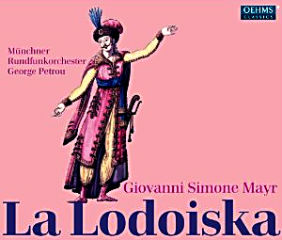
La Lodoiska is a jewel
composed by Giovanni (Johannes) Simone Mayr (1763-1845), a contemporary of Mozart and Beethoven. Although he did receive instruction in music at early age, Mayr did not have the chance to systematically study composition until he was in his mid-twenties when he came a pupil of Ferdinando Bertoni, the maestro di cappella of San Marco in Venice.
While being confronted with younger fellows like Paer and Nasolini, he nevertheless made his rapid raise to fame as a composer with such works as Sisara and Saffo. His triumphant success came with La Lodoiska at La Scala di Milan, which later became Napoleon’s favorite opera.
In spite of these international successes, in 1802 Mayr surprisingly decided against a career as director or conductor of any at the several major opera houses. Instead, he took up the post of maestro di cappella at the Basilica Di Santa Maria Maggiore in Bergamo. Shortly after, Mayr established a music school, which became well renowned and still exists today, its most famous pupil being a certain Gaetano Donizetti. Mayr became practically the standard composer for La Scala and for the then still more famous Teatro San Carlo di Naples.
His buddy Gioacchino Rossini called him the “father of the Italian opera,” which brings us to Mayr’s style. His is a preliminary introduction to what we call belcanto today, while embedding an elegant German undertone. It is like listening to Beethoven, Haydn, Donizetti and Mozart at the same time.
The central focus of Lodoiska, which is full of turbulence and power politics, is on a couple trying to find each other. Gripping and suspenseful from beginning to end, this tableau is supported throughout by the action of choral and ensemble scenes.
In 17th century Poland on the border with Tartary, Princess Lodoiska has been entrusted by her father to the care of Boleslao, lord of the Castle of Ostropoll. Boleslao wants to marry Lodoiska, but she is in love with Lovinksi and rejects his advances.
When Lovinski arrives (under the name “Siveno”) to ask for Princess Lodoiska on behalf of her father, Boleslao refuses to let her go. When Lodoiska’s father, Sigeski, arrives and confronts him, the tyrannical Boleslao imprisons both Sigeski and Lovinski and plans the death of the young lovers. All are saved at the end when they are rescued by Giskano, a Tartar warrior-prince, whose life Lovinski had once saved.
Lodoiska is portrayed by soprano Anna Maria Panzarella whose fragile lyric soprano amazes the whole universe by making all the way through the end, as Lodoiska is pretty much present in all scenes. Nevertheless, she is gifted with a beautiful instrument and shows a considerable effort to sing with emotion.
While mezzo-soprano Elena Belfiore‘s Lovinski is far from impressive, tenor Jeremy Ovenden shows a seamless legato and lyricism as Boleslao, though to me it is hard to figure out why Mayr gave such a part (father) to a tenore leggero. The rest of the cast Elvira Hasangacic (Resiska), Ines Reinhardt (Narseno), Nam Won Huh (Rodoski), Marc Megele (Sigeski) and Marko Cilic (Giskano) read their parts nicely. The chorus is somehow dull in the first act, then shows off in the second and redeems itself.
The performance, which appears to be recorded from a concert version is religiously conducted by George Petrou, and the Münchner Rundfundorchester obeys him well. On this 2-CD set by Oehms Classics, as this is often the case with rarely recorded and performed operas, there is no proper track list. Even worse, although the opera is in Italian, the full libretto provided is in German!
This is a rare opportunity for those interested in the history of art lyrique, who will be delighted to see what the more famous and endured composers got their inspirations and motivation from. This is a true “référence.”


























Comments